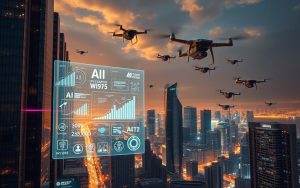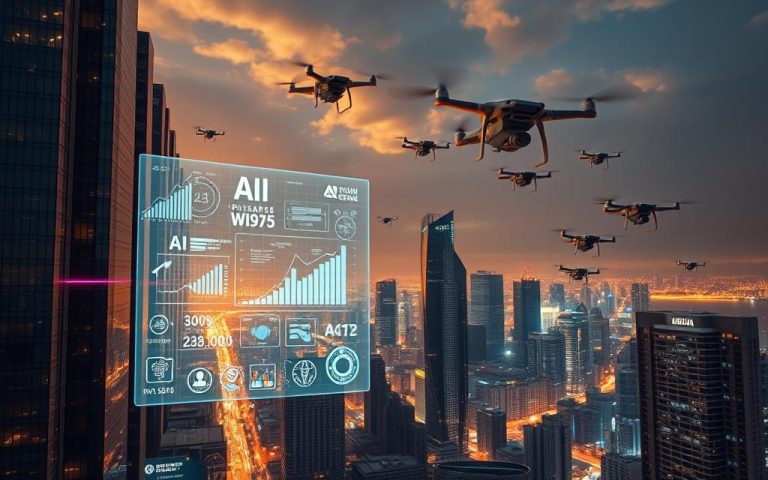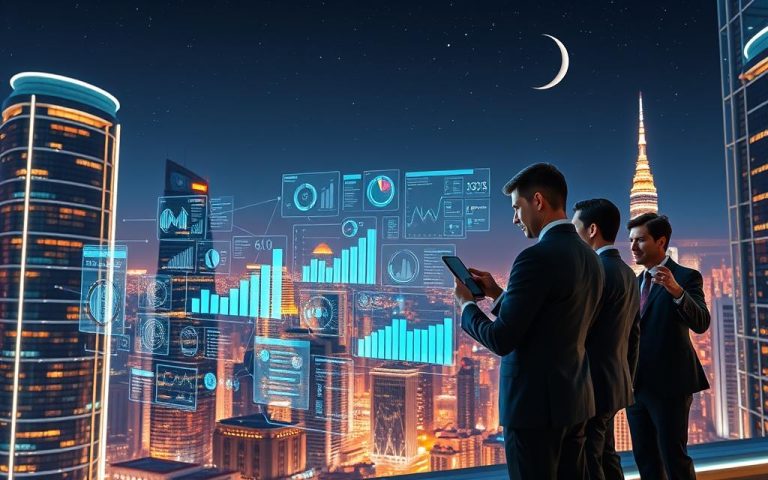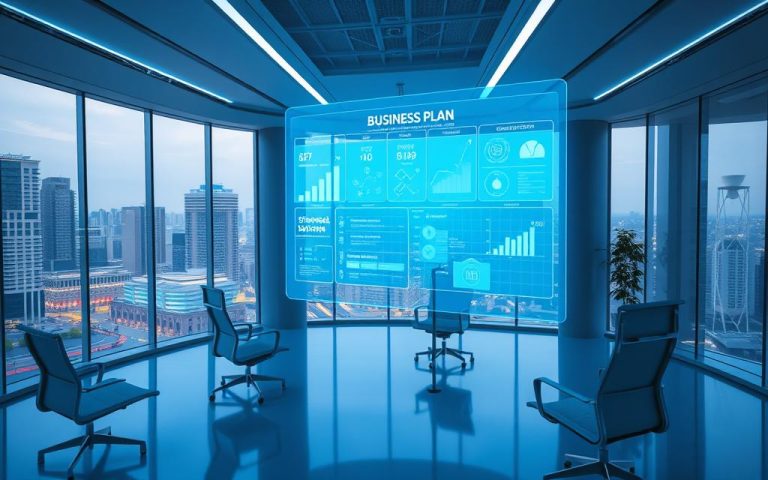How Businesses Are Using Generative AI in 2025
Generative AI has revolutionised business capabilities. It’s changing how firms tackle complex challenges and make strategic decisions1. After three years of widespread use, generative AI shows significant growth across industries1.
Yet, businesses face major implementation hurdles. Few companies have data systems ready for AI integration1. Old tech and scattered data networks hinder smooth generative AI deployment1.
Smart AI adoption needs a careful approach. Firms now focus on enhancing human work, not full automation1. They’re advised to target high-impact projects that bring clear value1.
Business AI abilities are growing fast. Forecasts suggest huge productivity gains1. Salesforce plans to deploy a billion AI agents for workflow help next year1. This marks a transformative era for generative AI in business2.
As firms navigate this tech landscape, employee upskilling is vital. Building a workforce with curiosity, scepticism, and adaptability is key to successful AI integration1.
The Evolution of Enterprise AI Capabilities
AI language models are revolutionising the tech world. Businesses are experiencing a massive shift in computing power. This change is reshaping how companies work and innovate generative AI is revolutionising enterprise technologies.
Advanced Language Models Driving Transformation
Modern AI models now boast impressive reasoning skills. They’ve moved beyond simple text generation. Multimodal AI is emerging as a groundbreaking technology3.
This new AI can process and create various content types seamlessly. Morgan Stanley’s AI assistant, for example, quickly accesses vast research databases3.
Beyond Textual Boundaries
The shift from text-only AI to multimodal AI is a huge leap. Key advances include:
- Integration of text, audio, and video processing
- Enhanced contextual understanding
- Cross-platform content generation capabilities
Infrastructure Powering AI Capabilities
AI infrastructure is evolving to meet complex computing needs. Leaders agree that advanced hardware and new training methods are vital4.
| Technology Focus | Leadership Perspective (%) |
|---|---|
| Multimodal Capabilities | 44% |
| New Training Techniques | 35% |
| Advanced Hardware | 21% |
The future of enterprise AI lies in sophisticated, adaptable computational ecosystems that can process and generate complex, multi-dimensional content.
How Businesses Are Actually Using Generative AI
Generative AI is reshaping business operations across sectors. It’s helping organisations boost efficiency and drive innovation through smart tech solutions. More companies are using AI-powered strategies to streamline processes and gain an edge.

Automated Workflow Integration
AI workflow automation is changing how businesses handle complex tasks. It’s boosting productivity and saving employees significant time. Localiza&Co cut monthly working hours by 8.3 per employee5.
Insight staff gained four hours weekly through advanced data summarisation5. This shows the power of intelligent automation in the workplace.
- Reducing manual administrative tasks
- Streamlining repetitive processes
- Enhancing overall operational efficiency
Customer Service Enhancement
AI-powered customer service is changing how businesses interact with clients. Chatbots and virtual assistants now offer quick, personalised customer experiences6. Best Buy plans to launch an AI virtual assistant in summer 2025.
ING Bank’s AI chatbot has greatly improved the quality of query responses6. These innovations are setting new standards in customer service.
Product Development and Innovation
AI-driven innovation is speeding up product development across industries. Companies use generative AI to create smarter, more responsive solutions. Etsy uses Vertex AI to improve search recommendations, boosting seller growth6.
Michelin saw a tenfold productivity increase through generative AI use5. This shows how AI can dramatically improve business outcomes.
Generative AI is not just a technological tool, but a strategic transformation engine for modern businesses.
Strategic Implementation of AI Agents in the Workplace
AI workforce integration is reshaping modern businesses. Digital workers are now a reality, transforming organisational structures. Over 72 percent of companies now use AI solutions, signalling a major shift in workplace tech.
Human-AI collaboration boosts productivity in remarkable ways. Agent systems streamline complex processes effectively. They can reduce review cycle times by 20 to 60 percent in loan underwriting.
This change creates intelligent ecosystems where AI enhances human expertise. It goes beyond simple automation, offering a new approach to work.
- Automated workflow optimisation
- Enhanced decision-making capabilities
- Improved operational efficiency
Digital workers unlock significant productivity gains. Generative AI automates repetitive tasks, freeing employees for strategic work. This could boost productivity by up to 40% across various industries7.
| AI Integration Area | Productivity Impact |
|---|---|
| Software Development | 20-60% Process Efficiency |
| Customer Support | 30% Satisfaction Improvement |
| Data Analysis | 70% Market Trend Identification |
Businesses must grasp the nuanced implementation of AI agents. Integrating these systems while maintaining human oversight is key. This approach will define competitive advantage in the emerging digital workforce8.
Managing AI Integration and Risk Assessment
Businesses now see the vital need for strong AI risk management strategies. Generative AI requires thorough approaches to lessen challenges and safeguard organisational interests9. Integrating AI successfully needs a strategic plan that balances innovation with responsible growth9.
AI compliance is a top concern for companies using new technologies. Organisations must create advanced systems to tackle data privacy risks and regulatory issues10. Protecting sensitive information requires careful attention and strict controls against unauthorised access10.
Responsible AI growth needs a varied approach covering technical, ethical, and strategic aspects. Companies should begin with focused use cases that match their main goals9. Advanced data systems and thorough talent growth are key for using generative AI well9.
AI governance’s changing landscape requires teamwork between data experts, compliance staff, and business leaders. A proactive and open approach to AI integration helps build trust. It also reduces risks linked to new technologies10.
FAQ
What is generative AI and how is it transforming business operations?
How are enterprises implementing AI capabilities in their current operations?
What are the primary business applications of generative AI?
How are AI agents changing workplace dynamics?
What are the key risks associated with AI integration?
How can businesses prepare for AI integration?
What technologies are driving generative AI advancements?
How is generative AI impacting product development?
What skills are becoming essential in an AI-integrated workplace?
How are businesses ensuring ethical AI use?
Source Links
- https://mitsloan.mit.edu/ideas-made-to-matter/6-ways-businesses-can-leverage-generative-ai
- https://www.mckinsey.com/capabilities/mckinsey-digital/our-insights/superagency-in-the-workplace-empowering-people-to-unlock-ais-full-potential-at-work
- https://www.databricks.com/blog/how-real-world-enterprises-are-leveraging-generative-ai
- https://www2.deloitte.com/us/en/pages/consulting/articles/state-of-generative-ai-in-enterprise.html
- https://blogs.microsoft.com/blog/2025/02/05/https-blogs-microsoft-com-blog-2024-11-12-how-real-world-businesses-are-transforming-with-ai/
- https://cloud.google.com/transform/101-real-world-generative-ai-use-cases-from-industry-leaders
- https://www.kornferry.com/insights/featured-topics/gen-ai-in-the-workplace
- https://www.mckinsey.com/capabilities/mckinsey-digital/our-insights/why-agents-are-the-next-frontier-of-generative-ai
- https://www.mckinsey.com/capabilities/risk-and-resilience/our-insights/how-generative-ai-can-help-banks-manage-risk-and-compliance
- https://www.pwc.com/us/en/tech-effect/ai-analytics/managing-generative-ai-risks.html













